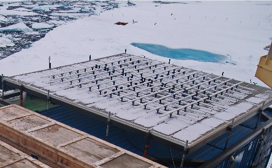Arctic Summer Cloud-Ocean Study
Wind profilers
Two Doppler wind profilers were used in ASCOS; one radar profiler transmitting at 449MHz and one SODAR (SOund Detection and Ranging) transmitting audible sound pulses at several wave lengths. Both work from the same principles, transmitting beams at an angle to the vertical in different directions. Using the Doppler shift of the return signals and algebra the wind speed and direction can be estimated. Both instruments are phased-array instruments, meaning that there are no moveable parts generating the different beams at different angles; this is instead accomplished electronically. The 449MHz wind profiler is sensitive to water vapor in the atmosphere and hence has the best results in moist air, and was deployed at the start of the ice drift on top of the port three containers located on the roof of the foredeck lab and operated through the rest of the expedition. Its return signal strength can, in addition to the Doppler information, be used to analyze the vertical structure of the atmosphere but only in a relative sense since the water vapor content is variable. The SODAR is sensitive to water vapor fluctuations (turbulence) and its return signal can therefore, in addition to the Doppler information, be used to derive information about turbulence in the boundary layer. The SODAR is sensitive to ambient noise and hence was deployed on the ice and only operated during the ice drift.
Download
 Photo of the 449MHz radar wind profiler with a cover of snow. The long crossing white rods are the radar antenna elements.
Photo of the 449MHz radar wind profiler with a cover of snow. The long crossing white rods are the radar antenna elements.